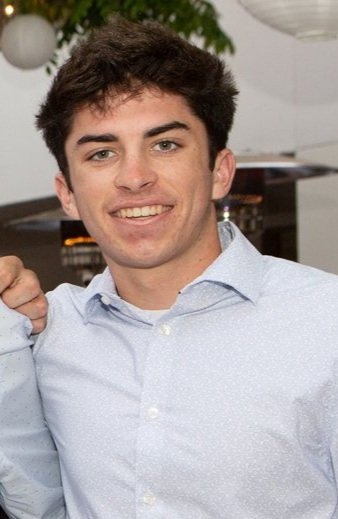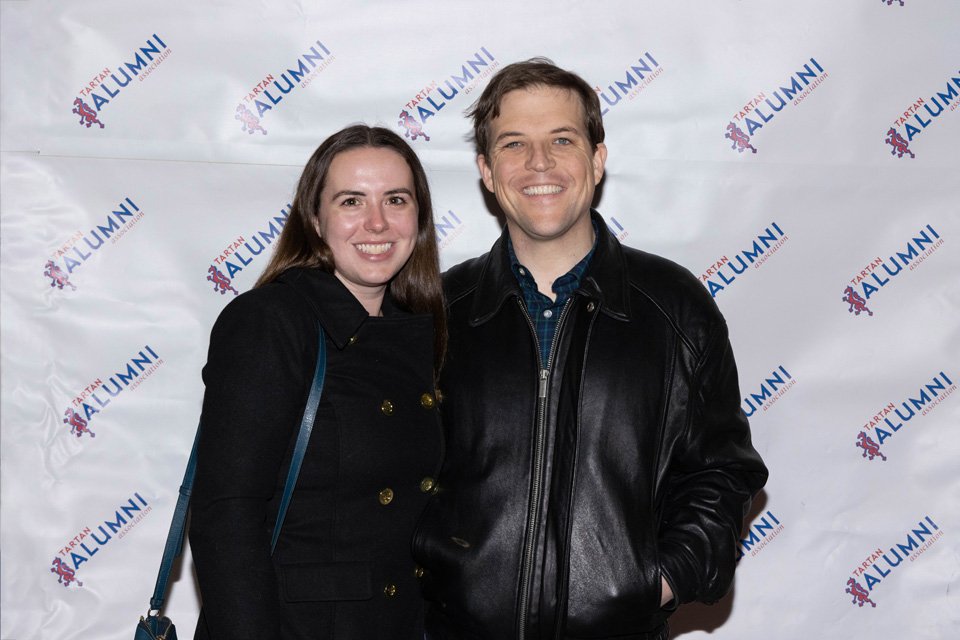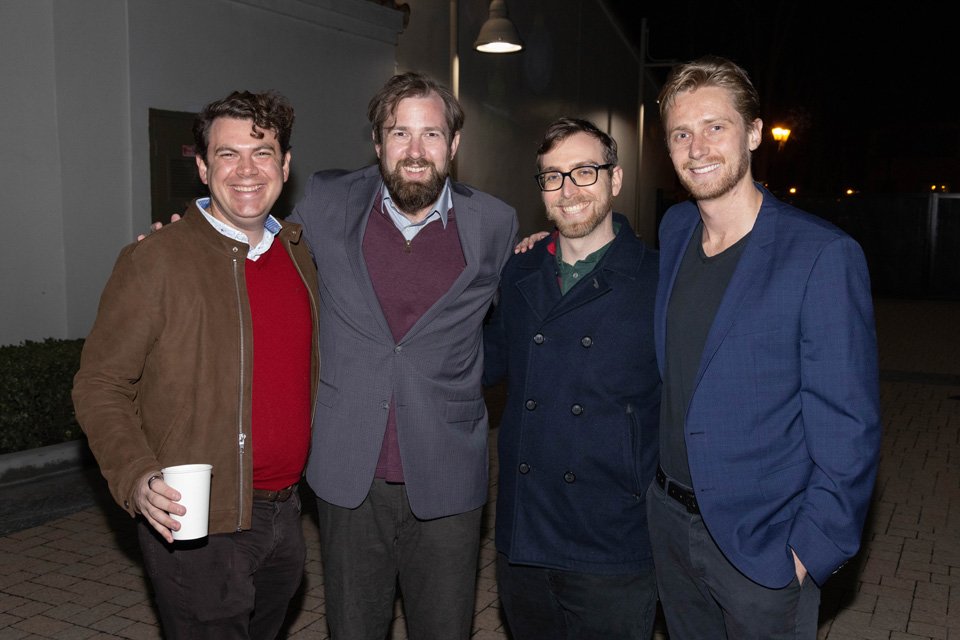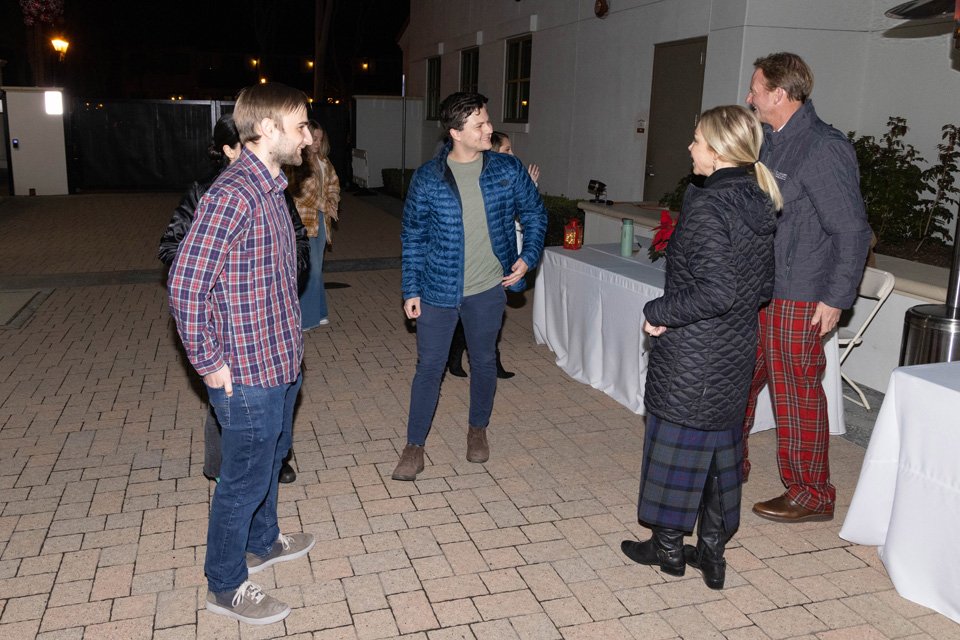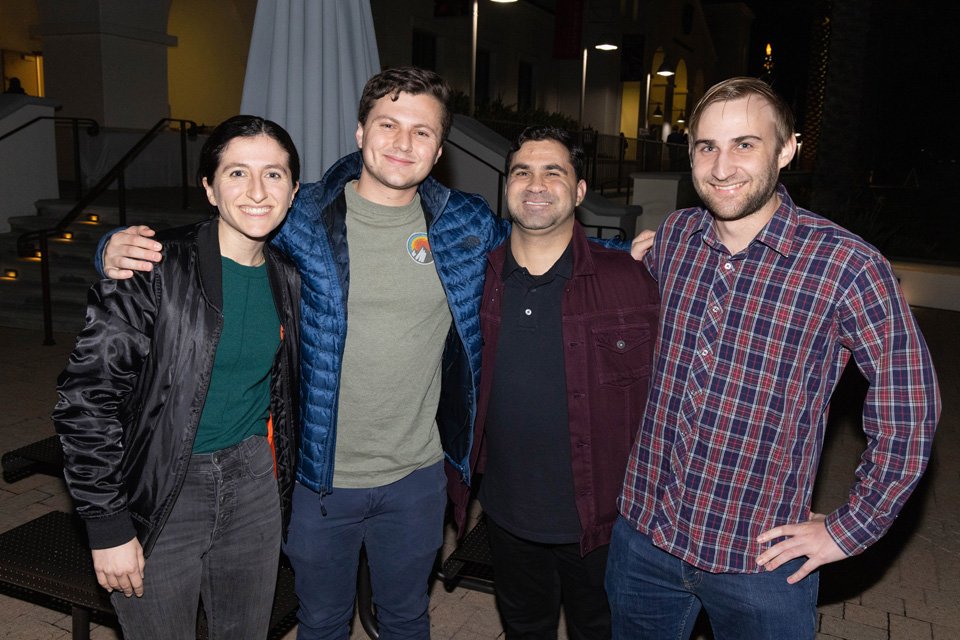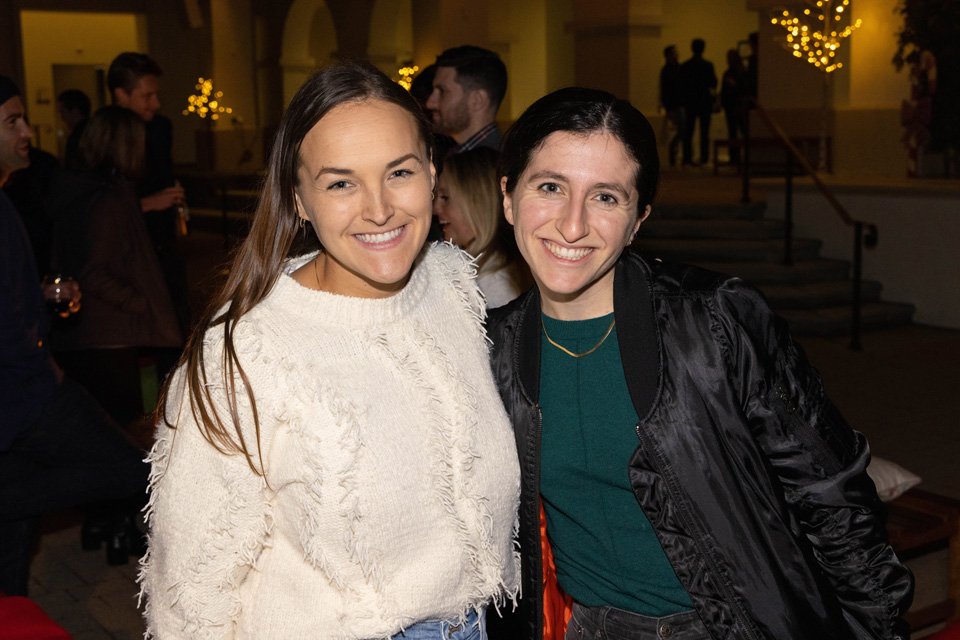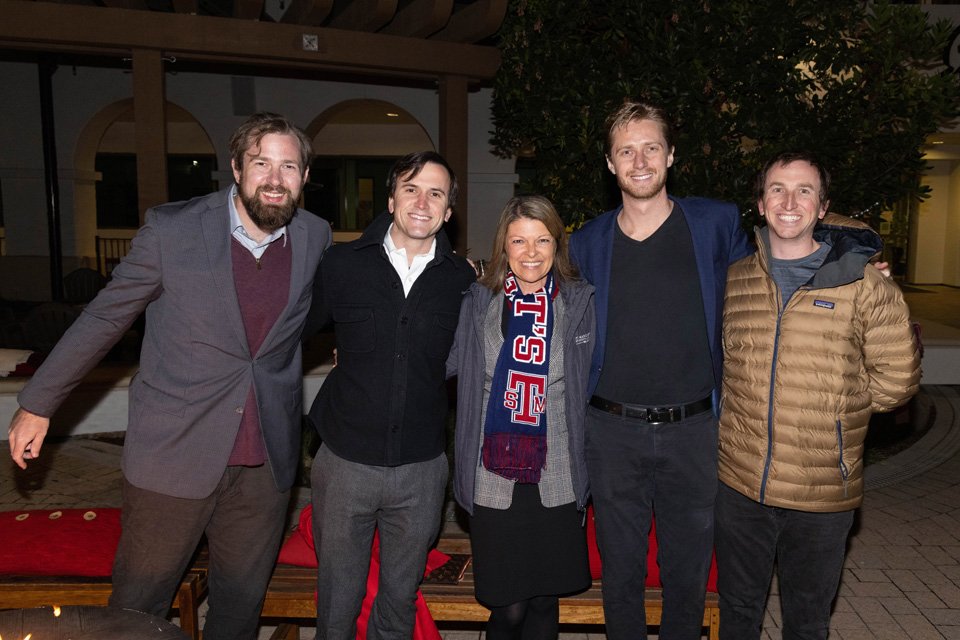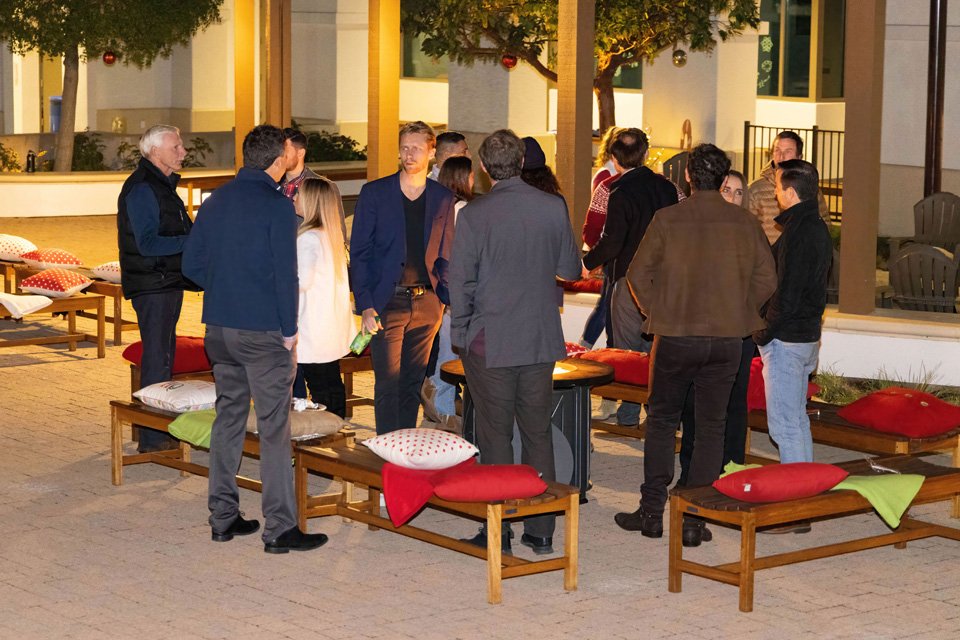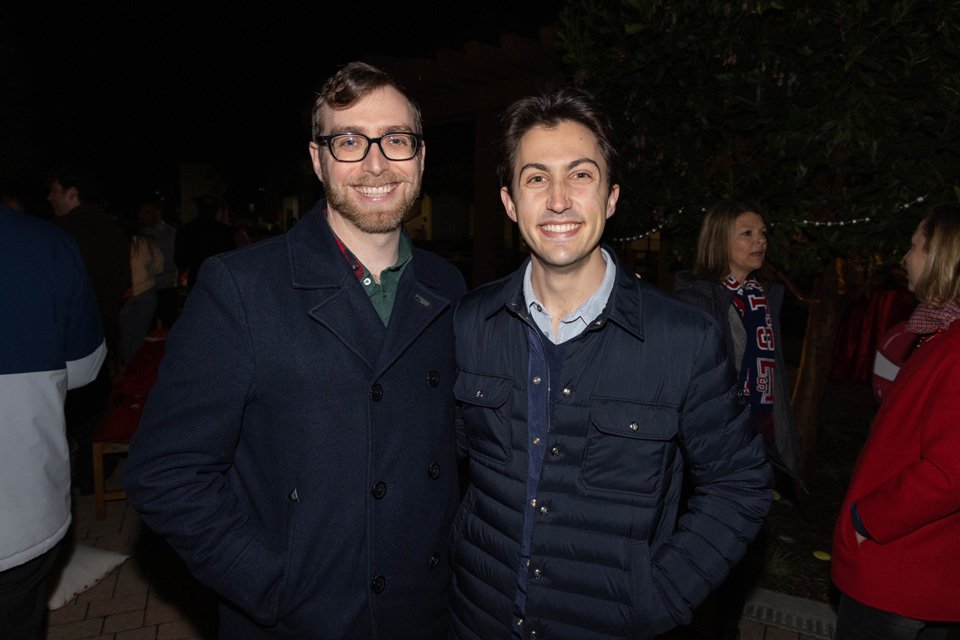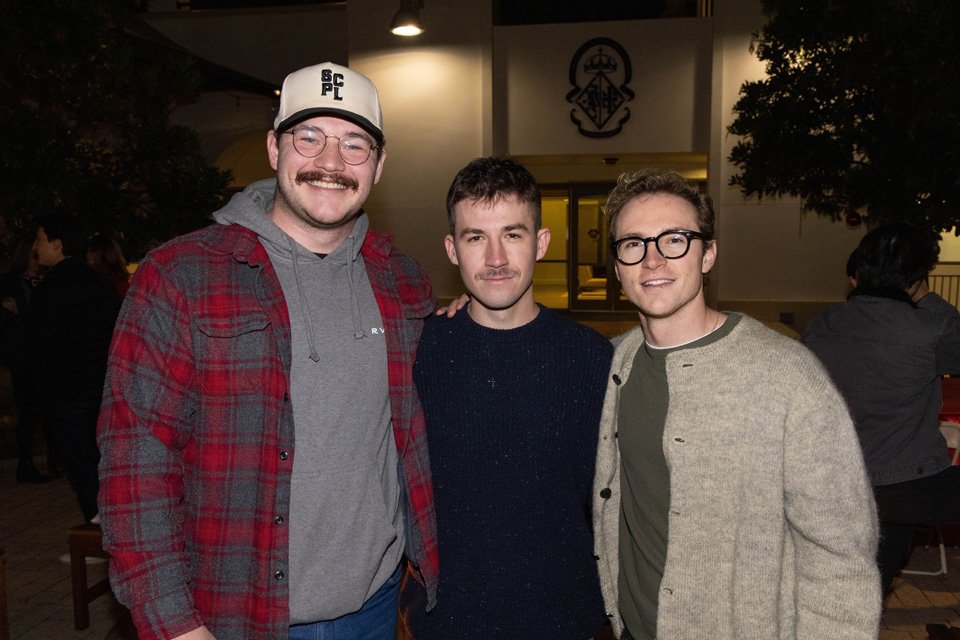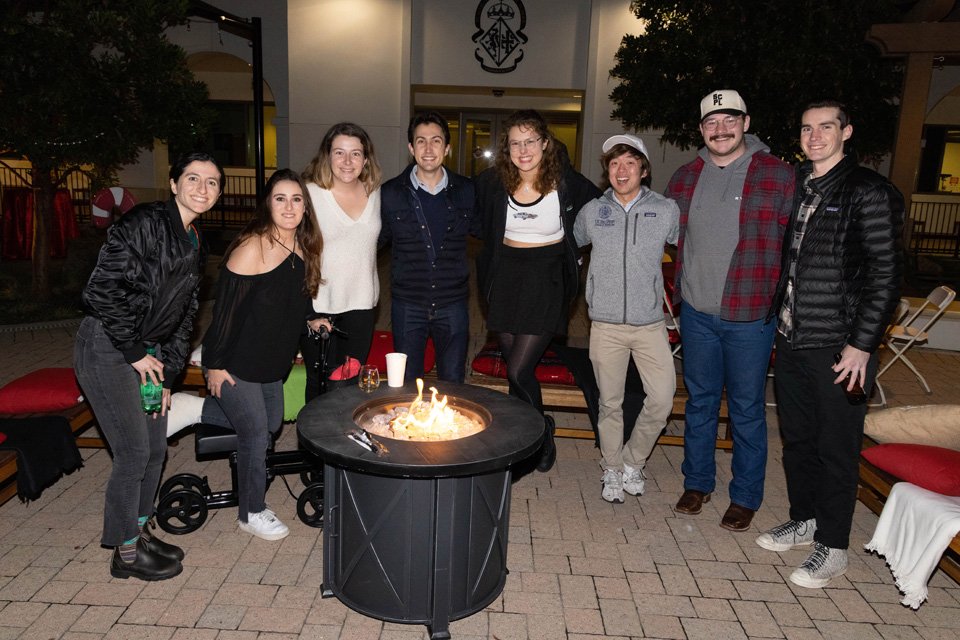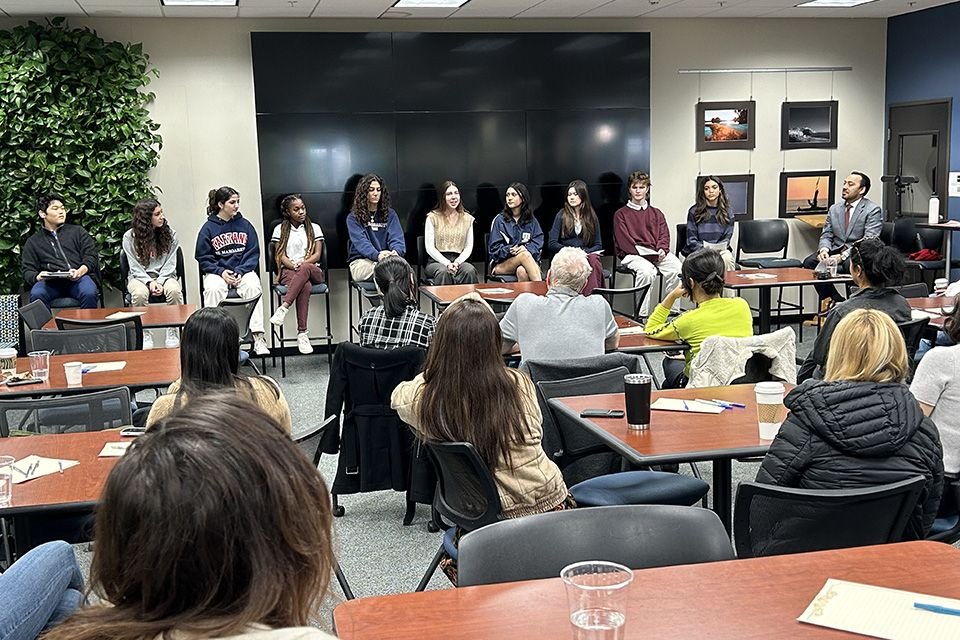Tartan Snapshots: Spring 2023
The latest news from around St. Margaret’s.
16 Upper School Students Conduct College-Level Research Through Partnership With UC-Irvine
Sixteen Upper School students with an interest in STEAM fields had a valuable first-hand look at a college research environment, as they worked with top minds in engineering, computer science, chemistry, robotics and more at the University of California, Irvine.
The partnership between St. Margaret’s and UCI Samueli School of Engineering is now in its 18th year, and the 16 participating students this summer was the highest number ever.
Lower School Starts ‘Scottie Snack Cart’ With Nutritious Food Options
St. Margaret’s unveiled its new health and well-being program, as Lower School students were able to snack on nutritious fruits and vegetables during recess from the “Scottie Snack Cart.”
The cart was made possible by a PTF grant in partnership with Upper School student Chase Springer and several professional community members. The fruits and vegetables were grown nearby at The Ecology Center, an educational partner of St. Margaret’s.
Holocaust Survivor Visits With Upper School Students to Share Remarkable Life Story
In a powerful and inspiring telling of a remarkable life story, students in the Upper School’s Holocaust and contemporary genocide course listened to a first-hand account of devastation, unthinkable loss and survival from the Nazi regime during World War II from a very special guest: St. Margaret’s grandparent Ruth Hermann.
Mrs. Hermann is the grandmother of Upper School student Carly Hermann. She was born in Stuttgart, Germany, in 1927, and at the age of 11 fled Nazi Germany as part of the Kindertransport program.
Grade 6 Students Explore Their Heritage and Enjoy a Feast
St. Margaret’s grade 6 students enjoyed a multicultural feast like never before, the culmination of a unit that explored each student’s family traditions and histories.
The Heritage Cookbook project was an interdisciplinary unit between grade 6 world history, taught by Rian Otto, and grade 6 writing, taught by Owen Beitner. The feast was just one of many activities students did to not only learn more about where they came from, but also to celebrate and experience a part of everyone’s unique story.
Large Tartan Delegation Attends NAIS People of Color Conference
St. Margaret’s had a delegation of 23 students and professional community members attend the 2022 National Association of Independent Schools’ People of Color Conference and the adjacent NAIS Student Diversity Leadership Conference in San Antonio, Texas.
The Tartan delegation consisted of six Upper School students and 17 adults. They participated in workshops and attended events over four days, advancing St. Margaret’s ongoing strategic work around fostering an inclusive school community and developing cultural competency skills to effectively engage across cultures, perspectives and backgrounds.
St. Margaret’s Expands ‘Digital Mentor’ Program for Middle School Technology-Use Education
St. Margaret’s Middle School students are learning valuable lessons in digital citizenship and responsibly navigating technology from those who perhaps best understand the world they are experiencing—fellow Tartans.
This year, St. Margaret’s expanded its “digital mentors” program, where Upper School Peer Counselors lead digital health and well-being lessons designed for Middle School students. This year, the program has expanded with 27 Upper School students—one for each Middle School advisory—leading lessons created by The Social Institute, St. Margaret’s partner in technology-use education.
Upper School Students Recreate Henry David Thoreau’s Famous Desk
As part of an interdisciplinary unit studying Henry David Thoreau and his American Transcendentalist philosophy, English and engineering students came together to build replicas of Thoreau’s 19th-century writing desk using only a set of antique hand tools.
The unit was conceptualized by Upper School English teacher Jamie Bunch and engineering teacher Eric Trumbauer as a way to better experience Thoreau’s self-reliant philosophy and how he lived it, while also offering students a new perspective on engineering and design as it used to be done.
Early Childhood School Teachers Present at NAEYC Conference
St. Margaret’s was well represented at the National Association for the Education of Young Children’s annual conference in Washington, D.C., as Assistant Director and Pedagogista Sonia Yoshizawa presented while Early School teachers Jennifer Hardison and Sharon Benedetto also attended and participated in presentations and forums.
Dr. Yoshizawa’s presentation was titled “Inquiring Minds: Investigating STEM with Infants and Toddlers” which describes a new model for how infants and toddlers engage in inquiry learning and provides educators with ideas for exploring STEAM learning opportunities to support inquiry for the youngest learners.
24 Upper School Students Recognized by National Merit Scholarship Program
St. Margaret’s celebrated 24 Upper School who were recognized by the National Merit Scholarship Program, based on their performance in the PSAT taken as juniors. St. Margaret’s had seven students named National Merit Semifinalists, and another 17 students received commendation.
There are 1.5 million National Merit Scholarship entrants nationwide, with the top 3 percent receiving commendation, and the top 1 percent being named semifinalists.
Arts
St. Margaret’s Performing Arts Center Named in Honor of Darcy Rice
St. Margaret’s announced hat the Performing Arts Center has been named the Darcy Rice Center for the Arts, in honor of the school’s longtime director of the arts who retired in June after a 22-year career at the helm.
Naming the building after Mr. Rice had been in the works for a long time. The Nicholas family provided the foundational gift to St. Margaret’s to build the state-of-the-art Performing Arts Center, which was completed in 2012. As part of that gift, the Nicholas family retained naming rights for the building.
“From the very beginning, our family believed that Darcy Rice was the only person worthy of having his name on the Performing Arts Center,” said Stacey Nicholas, a St. Margaret’s Trustee Emeritus and parent of three alumni who were all involved in the arts. “We thought that when he retired, it would be the perfect time to make that happen.”
Tartan Writers and Artists Honored With Regional Scholastic Awards
St. Margaret’s talented writers and artists in the Upper School and Middle School were recognized in the 2023 Regional Scholastic Art & Writing Awards. Tartans won 73 art awards and 28 writing awards in the West Coast Regional At-Large Divisions. That total includes 23 gold key winners, which will be forwarded for judging in the national competition.
Tartan Dance Launches New Buddy Program to Bring Students of All Ages Together
St. Margaret’s dance program spans all divisions and all grades of the school, with more than 140 dancers participating this school year. This year, Tartan Dance launched the buddy program, a cross-divisional touchpoint matching a Lower School dancer with either a Middle School or Upper School dancer for a year of connection, mentorship and learning.
Student-Athletes Commit to Top Colleges During Signing Periods
The Class of 2023 has had 19 student-athletes commit to continue their academic careers and play intercollegiate sports in college. The list includes nine student-athletes during the winter period, five from the fall period and five from the spring period.
A Decade to Remember
Under the leadership of Head of School Will Moseley, St. Margaret’s has experienced a transformative decade of innovation and excellence.
Under the leadership of Head of School Will Moseley, St. Margaret’s has experienced a transformative decade of innovation and excellence. A look back at a memorable 10 years at St. Margaret’s.
By Ryan Wood
Twenty-four words.
Will Moseley settled into his new job as the fourth Head of School in the history of St. Margaret’s back in the summer of 2013. He was eager to, as he likes to say, “start where you are.”
One of the first things on his list did not seem like an overwhelming task at all. It involved the careful dissection of one 24-word sentence—a simple statement that would drive a decade of decision-making, and take St. Margaret’s to new heights.
Our mission at St. Margaret’s Episcopal School is to educate the hearts and minds of young people for lives of learning, leadership and service.
Rare is it to find a school so driven by something as simple as a one-sentence Mission statement. Yet Mr. Moseley studied it closely. He took notes. He went to the Board of Trustees with questions. He asked how the school should interpret the phrase “hearts and minds.” He took special notice of the word “lives” and, of course, what those lives were to be educated to do. Learn. Lead. Serve.
The last decade at St. Margaret’s has seen full enrollment every year, a dramatic transformation of the campus, an innovative approach to strategic planning, a reimagined program for service learning, across-the-board success in academics, athletics and arts, and a new Core Value devoted to equity and inclusion.
To Mr. Moseley, whose time as St. Margaret’s Head of School will conclude after the 2022-2023 school year, it all stems from that 24-word Mission statement that guided the direction of the school and formed the bedrock of his vision.
“It’s important to understand the direction we are going together,” Mr. Moseley says now. “The clarity of direction provided by a Mission statement is central to a school’s success. If we execute our Mission, the outcomes will follow.”
Mr. Moseley starts every one of his presentations and meetings by reciting St. Margaret’s Mission statement to his audience, be it students, teachers, parents or alumni. Professional community members quickly memorize it and keep it front-of-mind when brainstorming innovative curriculum, new programming or strategic direction.
So where exactly is St. Margaret’s today? There are countless aspects that could be examined in-depth for a look at the progress that has taken place, but let’s focus on just a few: the school’s culture of innovation, a reimagined approach to service learning, capital projects, the growth of the alumni base, and a look into the future.
Culture of Innovation
In late 2015, St. Margaret’s Strategic Plan was due for a refresh.
Mr. Moseley had an idea.
For years, a thought danced around in his head. What if the Strategic Plan was a living, visionary process, not a static document that’s pulled out of a desk drawer every now and then?
How much higher could the school fly?
The Board of Trustees agreed, and the work began to architect this bold new path. In January 2016, the Board unveiled the Strategic Plan, purposefully constructed to realize the school’s Mission and Core Values. It was then handed over to St. Margaret’s professional community to implement action steps for achieving the larger direction identified by the Board.
Mr. Moseley appointed Ryan Dahlem to a new role of assistant head of school, where he was tasked with overseeing St. Margaret’s strategic initiatives. In the summer of 2016, Mr. Dahlem announced that the school would pursue strategic goals using the design-thinking methodology created by Stanford University’s d.School with inspiration from the fields of engineering, design and social science.
Strategic Plan work, 2016.
After learning how to utilize the methodology in August 2016, the professional community was off and running. They divided into self-selected teams and went through the steps of design thinking—empathize, define, ideate, prototype and test. They drew from the input of the entire Tartan community, especially the students (the “end user” in design-thinking methodology) to find actionable solutions to the Board’s strategic priorities.
In hindsight, Mr. Moseley considers it one of St. Margaret’s more impactful initiatives of the last 10 years.
“It altered the trajectory of the school, and created a culture where change is not something to be feared,” Mr. Moseley said. “We started to wrestle with big ideas. ‘How do we figure this out? Let’s start prototyping.’”
The Strategic Plan work brought a flurry of enhancements to the student and school experience, including:
- A redesigned school schedule in 2018 with an emphasis on student health and well-being. The new schedule featured a later start to the school day, consistent class times, breaks built into the schedule and blocks carved out for service learning and innovation.
- An innovation grant program, incentivizing the creation of new curriculum that blends disciplines and allows for cross-divisional connections. Students expressed an interest in both connecting with students in different divisions as well as integrating subjects to illuminate learning.
- The development of the Innovation Block in the Upper School, where students can pursue relevant learning opportunities outside the normal structure of class, from personal finance to food preparation to mindfulness.
- An emphasis of the health and well-being of students, which led to programs and initiatives like the Student Commons.
- A revamped service-learning program to strengthen relationships and meet the authentic needs of the local community (see below).
The innovative way St. Margaret’s approached strategic work captured the attention of top schools across the country. Mr. Moseley, Mr. Dahlem and others presented on St. Margaret’s Strategic Plan implementation at a variety of national conferences, including the CASE-NAIS Independent Schools Conference and the National Association of Independent Schools Strategy Lab Sandbox.
NAIS tabbed St. Margaret’s as one of the most innovative independent schools in the country at its 2019 annual conference, largely based on the school’s strategic work.
St. Margaret’s students returned to campus in the fall of 2020.
More importantly, though, the reimagined Strategic Plan transformed what was possible at St. Margaret’s. The new culture of innovation was given a major test in the spring of 2020, when the COVID-19 pandemic dramatically disrupted life around the world. At St. Margaret’s, the school went to work devising protocols, policies and safety measures to be implemented in quick time to see through Mr. Moseley’s goal of “Every Tartan, Every Day” – having Tartans back learning and interacting on campus, safely, as soon as possible.
The priority was a fruitful one. While schools around the country grappled with the challenge of educating students and maintaining a sense of community, the 2020-2021 school year went forward at St. Margaret’s with almost all students on campus for a large majority of the school year. Academic data shows that the “Every Tartan, Every Day” goal was crucial to student success, as Tartan students continued to grow academically at rates exceeding like schools through the pandemic.
In the eyes of Upper School Principal and Head of School-Elect Jeneen Graham, St. Margaret’s “became a different place” after the 2016 Strategic Plan launched.
St. Margaret’s Trustee Jason Weiss, who was Board President in 2016, agrees. “St. Margaret’s Strategic Plan has been lauded within the independent school community and proved dynamic in invigorating much of the great work that has been achieved at the school,” he said. “The outcomes have been consistent with our greatest hopes.”
Service Learning
Back to that deep-dive into St. Margaret’s Mission—Mr. Moseley studied it intensely, intrigued by the three desired outcomes of a St. Margaret’s education. Lives of learning. Lives of leadership. Lives of service.
Lives of service.
St. Margaret’s, through its Strategic Plan work and its closer examination of the school’s Mission, decided to look closer at its service-learning program a few years into Mr. Moseley’s tenure. The question burned—is service learning meeting its full potential at St. Margaret’s?
“We challenged ourselves to review how we dedicate time within the school program for service,” Mr. Moseley said. “Through our Strategic Plan work, we charged our service-learning team to seek new ways to incorporate service into the student experience and align the program across the school.”
The seeds started to sprout in the spring of 2017, when the service-learning leadership team designed a pilot program with a group of Upper School students with a high interest in service. They left campus during the school day several times over the course of the semester to perform service projects with a local school partner, Family Assistance Ministries.
It turned out to be a successful glimpse into the potential of service-learning at St. Margaret’s. Soon after, the Upper School moved away from a 70-hour service requirement for students and instead adopted a school-day program where advisories would develop a partnership with a local organization, which had the potential to endure through the entire four years of a student’s high school experience.
Upper School now engages in meaningful partnerships with organizations like Laura’s House, Special Camp, The Shea Center, Breakthrough SJC, local schools and more. Other divisions have adopted similar approaches, with the Lower School tying its service initiatives to each grade’s United Nations Sustainable Development Goal.
The 2022 All-School Service Learning Project was a partnership with St. Margaret’s Episcopal Church’s Infant Pantry.
St. Margaret’s also developed the All-School Service Learning Project, which has become an anticipated springtime tradition at the school. The project brings divisions together to meet the existing needs of a partner organization, provide a cross-divisional opportunity for student learning, and rally the school community around a common purpose.
The project had led to impactful partnerships in recent years with The Ecology Center, The Infant Pantry of St. Margaret’s Episcopal Church, Family Assistance Ministries, relief funds for Californians impacted by wildfires, and the Boys & Girls Clubs of Capistrano Valley.
The success of the All-School Service Learning Project, and Mr. Moseley’s leadership in reimaging service learning at St. Margaret’s, was profound. In March, the Board of Trustees honored this work when Board President Paul Westhead announced the William N. Moseley Venture to Serve. The Moseley Venture to Serve will have two annual components: the continuation of the All-School Service Learning Project, as well as the launch of a service venture fund.
In addition, Mr. Westhead announced the creation of the William N. Moseley Venture to Serve Endowment, which will generate income to ensure the future of the All-School Service Learning Project in addition to providing grants for students, alumni and professional community looking to create new and innovative ways to serve.
Capital Projects
The Maseeh Middle School grand opening in 2015.
When Mr. Moseley began his time at St. Margaret’s in the summer of 2013, there was no set timeline to move forward with the much-needed and oft-discussed fundraising and construction of a new Middle School campus.
Less than a year later, millions had been raised and construction was underway.
It was one of a series of significant upgrades to the campus during the last decade, as the campus master plan came into focus and the Tartan community supported the development of new campus spaces for students to learn, collaborate, interact and grow as people.
The Board of Trustees saw the 2013-2014 school year as a chance for Mr. Moseley to “listen and learn” as he settled into his new role. Major initiatives would wait.
Those plans changed just a few months later, when Mr. Moseley met with Mr. Weiss in September of 2013. There, Mr. Moseley expressed a desire to move forward with the development of a dedicated space for Middle School students to call home.
“Behind Will’s articulation of his vision of the Middle School and its intended impact on St. Margaret’s, the Tartan community rallied around this initiative,” Mr. Weiss said. “We raised more than $10 million in six months, and had shovels in the ground by June 2014.”
The Maseeh Middle School opened one year later in August of 2015, a triumph that instantly enhanced the learning experience and student life for grades 6-8.
There was no time for victory laps, however. The success of the Middle School sparked a forward-thinking push to enhance the campus in ways that would benefit student learning, growth, and community. The Maseeh Middle School was followed by:
- Highlands Quad and Chalmers Field (2016)
- Johnson Wallis Visual Arts Center (2017)
- Lower School Outdoor Classroom (2018)
- Lower School STEAM Center (2018)
- Ortega Administrative Center (2021)
A rendering of the Student Commons project.
In addition, the Board of Trustees enacted a policy to earmark 20 percent of all capital project fundraising toward St. Margaret’s endowment, a long-term pool of funds used to generate capital gains and interest income to support the annual operating budget. The growth of the endowment was significant over the past decade—from about $3 million in 2013 to almost $20 million in 2023.
An endowment also was created to support Breakthrough SJC, ensuring its future and supporting its mission to break the cycle of poverty through the power of education by serving students from underrepresented backgrounds. Recently, the headquarters of Breakthrough SJC, which is hosted and sponsored by St. Margaret’s, were moved to Campaigne Center as part of a 2022 campus upgrade.
The work continues, too. St. Margaret’s is currently fundraising for a major campus master plan project that will benefit the health and well-being of all Tartans. The Student Commons is a 30,000-square-foot, two-story building which will feature a from-scratch kitchen, a dining hall, a modern strength and performance center, and student-centered spaces for collaboration, downtime and more.
Tartan Alumni
Mattingly Messina graduated from St. Margaret’s in 2013, just a month before Mr. Moseley began his tenure as St. Margaret’s Head of School. Now the president of the Tartan Alumni Association and a member of St. Margaret’s Board of Trustees, Mr. Messina has a unique vantage point of the last decade of the school’s history.
Mr. Messina at the 2022 Senior Banquet.
“St. Margaret’s has remained the same in all the right ways: a caring community, a focus on academic and personal excellence, strong relationships between students and adults across campus, and an emphasis on service,” Mr. Messina said. “But St. Margaret’s has also transformed in ways our alumni can be proud of: stunning new buildings and facilities, a broader and more innovative academic curriculum, and a deeper emphasis on equity and inclusion.
“St. Margaret’s has grown into a nationally recognized independent school, and I often hear from our alumni that colleges and companies know a St. Margaret’s graduate is going to be a prepared and kind leader.”
As part of his role, Mr. Messina oversees relations between St. Margaret’s and its ever-growing alumni base. How much has it grown? When Mr. Messina graduated in the spring of 2013, he was one of 1,700 Tartan alumni, dating back to the first graduating class in 1986. Ten years later, he is one of 2,700.
As the alumni base grows, it intertwines into the St. Margaret’s community in new and more impactful ways. Today:
- Five of the last six graduating classes have had at least one student with a parent who also graduated from St. Margaret’s.
- There are more on the way! Today, more than 30 children of alumni are currently attending St. Margaret’s.
- There are 12 alumni currently working in the professional community at St. Margaret’s.
In addition, Tartan alumni span the globe, and are making noticeable impacts in the worlds of business, technology, law, medicine, the arts, nonprofits and much more.
“We now have thousands of alumni around the world and are ready to connect them as much as possible,” Mr. Messina said. “The next decade will be transformative as we see more of them send their own children to St. Margaret’s, return to work at their first alma mater, and provide the time, talent and resources to the school. The future of all independent schools rest on their alumni and we are dedicated to meeting all Tartans wherever they are.”
As a vehicle for alumni to connect and contribute to the St. Margaret’s experience, the Tartan Alumni Association launched the Tartan Alumni Legacy Endowment (T.A.L.E.) in 2014. T.A.L.E. is an endowment with income earmarked exclusively for St. Margaret’s Financial Aid program.
Mr. Messina looks back at the last decade as transformative for the alumni base at St. Margaret’s, and he sees the next decade being just as impactful in a variety of ways.
“We’ll see alumni folded into every area of our school,” Mr. Messina said. “We’ll see more alumni in leadership at St. Margaret’s, improved career programming, strong regional networks around the country, greater fundraising, and thousands of new Tartans to help keep our school’s Mission alive.
“Our goal is to show the world that St. Margaret’s takes that Mission seriously—that they prepare us for lives of learning, leadership and service.”
The Next Decade
St. Margaret’s celebrated its 40th anniversary during the 2019-2020 school year, with the school adopting the theme “40 Forward” as a nod to the Tartan spirit of growth, excellence, innovation and progress.
The 40th anniversary birthday party, October 2019
The slogan was perfect. Over the last decade, Mr. Moseley insisted on the need for St. Margaret’s to continually look forward—realizing the importance of a school’s success serving as a catalyst for continued growth.
“An academic institution that’s standing still,” he would often say, “is falling behind.”
It’s difficult to pinpoint exactly where St. Margaret’s will be in 2033, but the school’s rock-solid foundation, its culture of innovation, its expert faculty and staff and its strong and loving community are all key ingredients for continued excellence.
“It has been a memorable decade, with many achievements and accomplishments we should all be proud of,” Mr. Moseley said. “Yet I’m confident the best is yet to come for St. Margaret’s. The school is in great hands behind the leadership of Dr. Graham as the next Head of School. The careful guidance of our professional community, and the generous love and support of our parent and alumni community will take St. Margaret’s to new heights.
“The future is bright, and it’s exciting to think of all that is possible at St. Margaret’s in the years to come.”
St. Margaret’s Strategic Plan has evolved into an Innovation Strategy, an ongoing model for strategic planning which continues to mirror innovation sectors like technology and design while putting it’s end users—St. Margaret’s students—at the heart of the process.
It’s an essential approach in a rapidly changing world, as education continues transforming to meet the needs of new generations of students.
The school is poised to continue its excellence in academics, athletics and arts. It will continue serving the local community in more authentic and meaningful ways. It will continue prioritizing the health and well-being of its students, with the planned Student Commons serving as a physical embodiment of that important commitment. And it will continue preparing young people for the rest of their lives, as a growing alumni base keeps expanding its impact on St. Margaret’s—and the world.
“It is an exciting time at St. Margaret’s,” Dr. Graham said. “The momentum we have collectively built over the last 10 years and beyond have put our school in a position to continue growing and pursuing a high standard of excellence for our students and the Tartan community. If the last 10 years have shown us anything, it’s that there’s nothing we can’t achieve together.”
Such trajectories are only possible through shared values, or as Mr. Moseley put it, “understanding the direction we are going together.” It is why he studied all 24 words of the school’s Mission statement from endless angles. It is why he shared those words with Tartans every chance he had, and why the community is marching forward with a unified commitment toward the school and its students, every single day.
Our mission at St. Margaret’s Episcopal School is to educate the hearts and minds of young people for lives of learning, leadership and service.
Those 24 words are a guiding light for St. Margaret’s Episcopal School—a school that has come a long way in the last 10 years, and a school with a bright future ready to be realized.
Tartan Scenes: Spring 2023
A look at community gathering happening around St. Margaret’s.
PTF Forever Plaid: All Hallows’ Evening
More than 400 members of the St. Margaret’s community came together for a spooky spectacle in support of the school in October, as parents, professional community, Trustees and alumni came to AV Irvine or the 2022 Forever Plaid: All Hallows’ Evening.
It was the first in-person Forever Plaid all-school fundraiser since 2019, and the energy and excitement was noticeable as attendees came together for a night of dinner, dancing and generous support of St. Margaret’s. In the spotlight was this year’s Fund A Need, a relaunch of the Student Commons project which aligns with the school-wide focus on community and student health and wellness. By the end of the night, more than $1 million had been raised in support of the initiative.











PTF Parent Up Speaker Series
St. Margaret’s PTF Parent Up Speaker Series pursued the theme of the “Helping Young People Thrive” in 2022-2023. The first speaker in the lineup was Dr. Tina Payne Bryson, who shared enlightening brain and attachment research to share how parents can best make a difference in the lives of children.
The second speaker was Dr. Nii Addy, who explored the science behind self-care and gave tips to support ourselves as we take on life’s numerous tasks.








PTF Tartan Family Fun Zone
The St. Margaret’s community gathered for an evening of great food, friendship, games and Tartan spirit, as the PTF Tartan Fun Zone welcomed more than 850 attendees to the Lower School Field.
The event was a warmup for the St. Margaret’s Homecoming football game later that evening, and it proved to be popular. Tables were full with Tartans socializing over delicious food, the Lower School field and Campaigne Center were filled with students playing fun games like sack races and dodgeball, and families were able to purchase Tartan gear from the PTF Boosters.






















PTF Welcome Back Coffee and Winter Coffee
The PTF hosted two get-togethers this school year for the parent community to enjoy coffee and community and learn more about volunteer opportunities within the PTF. The annual Welcome Back Coffee served as the traditional kickoff to PTF activities at the beginning of the school year, while a second Winter Coffee brought families back together to look ahead to spring events and activities.






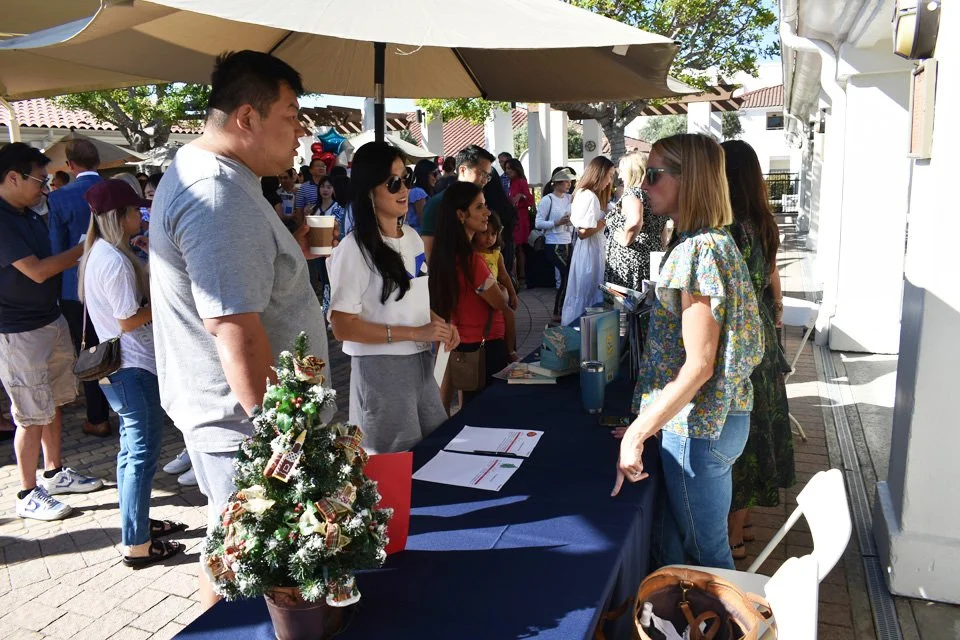












PTF Tree Lighting Ceremony
A cherished holiday tradition at St. Margaret’s brought more than 200 members of the Tartan community to the 15th annual PTF Tree Lighting Ceremony in the Fountain Courtyard.
Traditionally the kickoff event for the holiday season at St. Margaret’s, Tartans in attendance could visit with Santa Claus, decorate holiday ornaments to hang on the St. Margaret’s Christmas tree, listen to carolers and enjoy hot chocolate and holiday desserts. There was also an opportunity to write letters to Santa, complete with a special mailbox for messages to the North Pole.





























Alumni Class Notes
A look at recent updates in the Tartan alumni community.
2002
Class of 2002 Reunion
20th Reunion: The ‘02s celebrated their 20th reunion in October in San Juan Capistrano, reconnecting, reminiscing and catching up on news from their classmates!
Michael Boyle earned his Master in Public Policy degree from Princeton University last May, and is currently working at The Pentagon.
2012
Class of 2012 Reunion
10th Reunion: The Class of 2012 celebrated their 10th Reunion in December, getting together in San Juan Capistrano to catch up and share stories. It was great seeing everyone there!
2015
Morgan Higgins
Morgan Higgins was recently cast in Andrew Lloyd Webber’s Broadway musical Bad Cinderella, where she plays Marie.
2017
Soon after completing his degree from the University of California, Santa Barbara, Nick Scheel was named 2022 Lifeguard of the Year by the City of San Clemente for his work as a lifeguard supervisor.
2018
Jaden Cloobeck graduated from the University of Pennsylvania and now works as a researcher at the Milken Center for Advancing the American Dream in Washington, D.C. He recently joined Ian Thomas ‘09 on an alumni panel discussing college experiences and career paths with current St. Margaret’s students.
2019
Chris Chan was the recipient of the ROTC All American Student of the Year Scholarship, which was presented to him during the Military Bowl football game in December. The scholarship honors 3 ROTC seniors across the United States who embody the pillars of the ROTC program: leadership, military excellence, scholarship and service. Chris attends Villanova University and is part of the NROTC program.
Paul Boranian co-founded the company Golf Daddy and found immediate success when its top product, Divot Daddy, went viral on TikTok. Golf Daddy currently has more than 250 million views on TikTok and now has products in hundreds of retail stores around the country. He graduated from Pepperdine University in December.
In Memoriam: Wes Carr ‘19
The Tartan community was saddened to learn about the passing of Wes Reynolds Carr ‘19, who passed away in February in Dallas, where he was a senior and economics major at Southern Methodist University.
Wes had a joyful, outgoing personality and he was a kind and selfless person. He loved his family, friends and neighbors and had a special friendship with an elderly neighbor whom he helped with house chores and gardening. Wes loved sports and played both baseball and soccer while at St. Margaret’s. He was also a music lover and had a particular affinity for film. Wes was a good listener and an even better friend. He kept in close touch with his St. Margaret’s classmates, and made new friends during his years at SMU where he was a member of Beta Theta Pi fraternity. Wes will be deeply missed by all those who were so very blessed to know and love him.
2022
Xitlalic Rojas returned to St. Margaret’s this spring to speak to grade 8 students during the All-School Service Learning Project, which this year was a partnership with the Boys & Girls Clubs of Capistrano Valley. Xitlalic spoke about her experiences at the Boys & Girls Clubs, which included being named the BGCCV Youth of the Year in 2022.
Notable: Alumni Christmas Party
Tartan Alumni from many classes returned to St. Margaret’s in December for the annual Alumni Holiday Party. It was great seeing so many faces! Here are a few photos from the night:
Save the Dates!
Tartan Giving Week: May 12-16
Homecoming: October 13
Bringing a Core Value to Life: The Upper School TIDE Student Leadership Group
TIDE makes a visible impact when it reaches out to the school community, and there are plenty of examples this year.
TIDE students speak at a parent panel in February.
By Ryan Wood
St. Margaret’s junior Abby Sun, a member of the Upper School’s Tartan Inclusion and Diversity Education (TIDE) student leadership group, was asked about the hard work TIDE students have embraced this school year during a recent parent-education panel with the St. Margaret’s community.
“The only way to make change,” she said, “is to be actively involved in it.”
“Actively involved” is certainly an apt description for those in TIDE, one of seven student leadership groups in St. Margaret’s Upper School. Led by Director of Equity and Inclusion Victor Cota, TIDE is made up of 17 Upper School students who represent many different backgrounds and identities. For many of them, their desire to join TIDE is personal—a unique background compared to their peers, a passion for spreading empathy, a pursuit of a sense of belonging not only for themselves but for all St. Margaret’s students.
TIDE students have invested fully in their work this school year, something Mr. Cota calls inspiring.
Mr. Cota shares, “For years, the young people who have joined TIDE have done so because they believe deeply in honoring the dignity of every human being and the shaping a school experience where every Tartan is known and loved. This year’s group is no exception, but they have taken this charge to a whole new level. I am utterly amazed by their passion for impacting their Tartan community, including parents and younger peers. It’s a special thing to watch young people extend beyond themselves to make a change in others’ lives.”
While TIDE meets with Mr. Cota during a regular block to discuss current events, social-justice issues and conduct dialogue about important equity topics, TIDE makes a more visible impact when it reaches out to the school community. And this year, there are plenty of examples.
TIDE students partnered with a grade 3 class to engage in a three-part workshop series on kindness, compassion, and belonging. The TIDE students shared scenarios that they remember from their own elementary school experiences and processed the skills of resiliency and upstander behavior. In grade 6, students took part in a heritage feast day, the culmination of an interdisciplinary unit where students learn more about their family history and culture and prepare a family recipe as part of a grade-wide potluck. This year, senior and TIDE leader Luciana Varkevisser joined the festivities, sharing her family’s heritage and celebrating the work grade 6 students were doing. And in grade 8, TIDE students partnered with digital mentors and a subset of Upper School student leaders to visit the Middle School advisories and engage in a scenario workshop.
A TIDE Talk in the Upper School.
TIDE students also participated in a panel with professional community members as part of an in-service session around DEI and social justice in September. They have led ongoing “TIDEtalks” in the Upper School, which are student-to-student discourse opportunities centered around certain topics in the news. There was a parent-education panel in February, in which a majority of TIDE students participated and shared their perspectives and experiences around DEI work at St. Margaret’s and beyond.
TIDE students also lead programming around various cultural events, including holidays like Diwali and Lunar New Year and annual celebrations such as Hispanic Heritage Month, Native American Heritage Month, Black History Month, Women’s History Month and Pride Week.
Away from St. Margaret’s, six TIDE students traveled to San Antonio to attend the NAIS Student Diversity Leadership Conference in December, and two more joined a St. Margaret’s delegation at the Pollyanna Conference in San Diego.
It is all part of TIDE’s ongoing effort to bring to life St. Margaret’s strategic focus and core value around equity and inclusion, in which the school strives to “embrace and celebrate the identity of every human being while advocating for equity, inclusion and justice.”
It’s a core value that TIDE students have embraced—and have worked hard to see realized.
“It brings me so much joy to see people feeling like they belong here at St. Margaret’s,” TIDE student Leo Kitaen said at the parent-education panel. “That’s a community that I want to be a part of.”
The Future of the School Library Takes Shape at St. Margaret’s
For this generation of learners, the school library has an entirely new purpose. Consistent with the school’s culture of innovation, St. Margaret’s Library and its expert staff are at the forefront of that evolution—and plan to stay there.
By Ryan Wood
Close your eyes and envision a school library as it is traditionally set up. What do you see?
Maybe some tables with stiff, wooden chairs for studying or group work. Definitely shelves and shelves of books to be checked out, with that familiar library smell. Depending on how far back we are willing to go, maybe even a card catalog (remember those?).
Now, walk into St. Margaret’s Library and see how the space has evolved to meet the needs of students in today’s world. Quiet work areas. Collaborative setups. Comfortable furnishings. Maker spaces demonstrating the latest educational technology.
For this generation of learners, the school library has an entirely new purpose. Consistent with the school’s culture of innovation, St. Margaret’s Library and its expert staff are at the forefront of that evolution—and plan to stay there.
“We continue to evolve our school library to ensure its important role in serving students of all ages,” said Angela Mackenzie, director of educational technology and library at St. Margaret’s. “As the way students consume and access information innovates and adapts, so does St. Margaret’s.”
It’s not just the Library’s physical space evolving to meet the times—it’s programming and resources, as well. From classroom visits by Lower School students taking on a new look, to access to resources that puts a lifetime of learning at one’s fingertips, to the many options for students to unwind, catch up on academics or collaborate on projects, the St. Margaret’s Library continues to be a central space for the Tartan experience.
The students are noticing—and loving—its modernization.
“It’s my favorite place on campus,” said St. Margaret’s senior Jordan Reder. “The Library is vital to the student experience due to the overwhelming kindness of the Library teachers and its comforting atmosphere … It is incredibly versatile, containing a silent room for studying, an open space for all students, a drink station, and the study room. Every student has been provided with what they need or want, and the Library is evidence of the immense effort that St. Margaret’s puts in for their students.”
Physical Space
The Library Commons area, as it was in 2013 and as it is in 2023.
The Chronicle of Higher Education recently released a full-length special issue titled “The Library of the Future” which explored the innovation of libraries at colleges and universities around the country.
Specifically, it asked the question: How does a campus library stay essential, when unlimited terabytes of information, credible or otherwise, are available to anybody with an Internet connection?
“Despite worries about declining usage with the advent of the Internet, library buildings have remained a campus anchor and popular destination for students and scholars,” The Chronicle wrote. “As scholarly materials have shifted from paper to electronic forms, colleges have had to rethink what purpose a library building serves.”
The Chronicle issue focused specifically on college libraries, highlighting Lehigh University, Ohio State University, Kenyon College, Yale University and many more. Yet the point certainly applies to schools like St. Margaret’s. “As information has become available online,” the Chronicle writes, “libraries have gone through renovations to emphasize social connections, group study, and new services for students and scholars.”
Coffee and tea setup for students.
A quick tour of the Library shows how that’s certainly true at St. Margaret’s. As you enter through the familiar doors, the modernity of the St. Margaret’s Library quickly comes into focus. To your right, a coffee and tea area offers students a tempting place to take a break, enjoy a drink and recalibrate before taking on the rest of the school day. “Grabbing a hot tea on a rainy day has never failed to make things a little bit brighter,” Jordan said.
Enter the Commons area of the Library and what once was a wall of bookshelves has transformed into one of the premiere presentation spaces on campus.
Adorning the wall is a nine-screen display that can be configured in a variety of ways. Next to the video display is a 6-by-8-foot living wall, made of living plants and part of a pilot for biophilic design to bring nature indoors. Both projects were funded by the PTF Grant Enrichment program, which raises money through PTF events like the Library Luncheon, Forever Plaid All-School Fundraiser, and other initiatives throughout the year.
Beside the new presentation capabilities, the Commons area itself has seen a makeover in recent years. Couches, soft-back chairs and oversized board games make the place more inviting, and flexible and movable tables and chairs allow for reconfiguration to meet the needs of the classes and community events that frequently take place.
A Middle School computer science class in the Library makerspace.
Around the same time as these additions, the Library’s previous student studio spaces adjacent to the Commons area were renovated and transformed into a new emerging technology makerspace and classroom. Here, computer science and technology classes like the Middle School’s introduction to emerging technology class meet and a variety of technologies from virtual reality to robotics are available as learning tools. The school’s robotics team and the eSports club practice here as well.
And, tucked away in an easy-to-miss space at the corner of the Library Commons is a new NAP (Need a Place) room. This quiet room for Upper School students is by reservation only and is a spot for students to focus, relax or work without distraction.
The NAP room’s creation came as a result of a design sprint conducted by Mrs. Mackenzie and Assistant Head of School Ryan Dahlem with Upper School students earlier this year as a brainstorm for the new Student Commons project. As the school determines the best use of the second floor of the Student Commons, students were given the opportunity to volunteer their opinions and express their preferences for the space. At the top of many students’ lists was a quiet room to rest and recharge.
Intrigued by the student input, Mrs. Mackenzie decided to pilot a quiet room in the Library.
“We transformed a small office into a NAP room with a lounge chair and other relaxing features,” Mrs. Mackenzie said. “We set up a reservation system and it has been very popular so far.”
Programming
Throughout the day, students in red sweaters are seen lining up in a row along the breezeway separating the Gateway building and Chalmers Field. There, they wait quietly for Lower School digital literacy teacher Melissa Fisher to greet them outside and usher them in for their weekly lesson.
Each Lower School homeroom visits the Library twice a week. There remains a traditional book-browsing session, where students can find a book to check out and take home for a fresh read each week.
The second visit, however, is an innovative digital literacy lesson with Mrs. Fisher. There, students engage in interdisciplinary work centered around digital responsibility, digital leadership and lessons that implement the Lower School’s United Nations Sustainable Development Goals, Learning for Justice standards and grade-level social studies units.
A digital literacy lesson in the Library
Today’s students are immersed in a technology-driven world and have been since birth. As a result, digital literacy is increasingly becoming essential curriculum in a school, as students learn how technology can help them in their academic pursuits, while they also learn how to be good digital citizens and make safe, responsible and respectable decisions online.
Digital citizenship is taught to students in every division, and the Library staff has worked with the Upper School Peer Counselors to bring a student perspective to the curriculum, in particular during outreach to Middle School students.
Regular time in the Library is not just for Lower School students, though. Early Childhood School students also visit the Library regularly, engaging in storytime with Library technician Rosemary DeSa and searching among thousands of age-appropriate books to check out.
And each day at lunch, many Middle School students make their way over to the Library for device-free programming meant to provide a brain break away from screens. In addition to students unwinding with puzzles and games, students are encouraged to pursue Cricut design projects, paper circuits and maker cart creation projects during Lunch, led by Middle School Library teacher Darla Magana.
Each day, up to 40 Middle School students visit the Library during their lunch break to engage in the programming and enjoy downtime with their peers.
Resources
While St. Margaret’s Library doesn’t need as many physical books as before, the amount of information available to students is as vast as ever.
St. Margaret’s students have access to more than 50 academic databases—everything from encyclopedias, journals, magazines, videos, news wires, broadcast media transcripts, statistical data, and collections of primary sources dating back to the American Revolution.
“These are the same databases used in higher education, so our student access to resources is on par with what they will use in college,” Academic Research Technologist Stacey von Winckelmann said.
The sheer volume of data and sources at users’ fingertips, as well as student feedback, led to the creation of two historical research methods classes taught by Mrs. von Winckelmann in the Upper School. Introduction to historical research methods honors aims to introduce students to research techniques to prepare them for college-level academic research and writing, while advanced historical research methods honors applies those skills toward a semester of student-led inquiry that emphasizes research in the real world. Often, students choose to write an in-depth research paper to be submitted to The Concord Review.
The databases are only a sliver of the information available. There are still more than 12,000 physical books in the Library for students to check out, and subscriptions to newspapers, a digital library of e-books through Sora, and an expert Library faculty are available to help navigate each source.
The Future
The Chronicle of Higher Education concluded its in-depth report with a look into what’s next for campus libraries—a future that is hard to map given the many academic, societal and technological factors at play. Yet the publication forecasts that libraries will be an important hub in academic communities for years to come, as the physical spaces are ideal gathering spots, as scholarly resources continue to grow, and as society needs experts who can identify sources of valid information.
St. Margaret’s and its Library staff recognizes and embraces the evolution of this important campus space and its ever-changing role in serving students. Their goal is to make sure the Library continues to be a relevant and enriching place for St. Margaret’s students of all ages.
“We have gone through multiple transitions over the past three years,” Mrs. Mackenzie said. “We will continue to adapt and modernize and invest in emerging technologies, while still providing the services that our students need.”
St. Margaret’s New-Look Counselors Office Expands and Fine-Tunes Its Outreach
St. Margaret’s counseling team wraps up its first school year in a restructured, reimagined office.
By Ryan Wood
As St. Margaret’s counseling team reflects on its first school year in a restructured, reimagined office, all-school counselor Janice Avalone can’t help but notice the many positives that have come as a result.
“The need to be more division-specific was evident,” Dr. Avalone said. “We are able to connect in new ways and are seeing much stronger relationships this school year. It has been a big positive.”
Dr. Avalone, who has been at St. Margaret’s for 25 years, is joined in the counseling office this year by two new all-school counselors, Derek McIntire and Victoria Anaele, who bring a wealth of experience in working with young people. In addition, St. Margaret’s counseling office works closely with Dr. Greg Koch, a licensed clinical psychologist who leads St. Margaret’s Learning and Enrichment Center (LEC).
As school-aged children work through mental-health challenges at a rate unseen in previous generations, St. Margaret’s felt an urgency to expand the counseling office’s scope and fine-tune its strategy of serving students. Starting this school year, one counselor is dedicated to each division—partnering with faculty and being the resident expert on the age groups.
Dr. Avalone focuses on Upper School and Early Childhood School, with Mr. McIntire in the Middle School and Ms. Anaele in the Lower School. The restructuring has led to deeper relationships between counselors and the students, teachers and deans they frequently work with.
Those division-specific labels, however, are not without flexibility. Each counselor has an open-door policy for students.
“We want our community to know that any student can come to any of us,” Dr. Avalone said. “We work in constant collaboration with our team and Dr. Koch. Though our outreach is often division-specific, we are all available for anyone.”
St. Margaret’s counseling office approaches its work as a three-tiered pyramid, with the goal to reach 100 percent of the student body at an appropriate level for each student’s individual needs.
For Tier 1, which encompasses most students at St. Margaret’s, those touchpoints come in the form of school-day programming, often around research-backed social-emotional learning opportunities. Social-emotional learning, or SEL, is an educational framework which builds competencies in key areas such as:
Self-Awareness: Recognizing feelings as they occur, having a realistic assessment of one’s own abilities and values.
Management: Handling emotions so they facilitate rather than interfere with the task at hand.
Social Awareness and Cultural Competency: Seeing what others are feeling; being able to understand and have empathy for diverse perspectives.
Relationship Skills: Handling emotions in relationships effectively; establishing and maintaining healthy relationships based on cooperation; establishing and respecting personal boundaries; negotiating solutions to conflict.
Compassionate Decision-Making: Accurately assessing risks, making decisions based on a consideration of all relevant factors and the likely consequences of alternative courses of action.
Such Tier 1 programming takes on multiple meanings. In the Upper School, it involves Peer Counselors facilitating workshops in grade 9 Advisory, seasonal programming such as Red Ribbon Week, class meeting workshops, and training for teachers and parents. Middle School students engage in SEL lessons in Advisory, digital literacy lessons with Upper School Peer Counselors, and seasonal programming. In the Lower School, monthly character talks take place in grades 4 and 5 with the counselors available to younger classrooms upon request.
For students in need of more outreach and resources, the counseling team sets up small group “Scottie Circle” small-group social-emotional instruction (Tier 2) as well as one-on-one support for individuals with an identified need (Tier 3).
This approach has shown promising results, and not a moment too soon. Studies have shown that young people have experienced soaring rates of mental health challenges, which was exasperated by the COVID-19 pandemic’s disruption of daily life. The American Academy of Pediatricians, the American Academy of Child and Adolescent Psychiatry and Children’s Hospital Association jointly declared a national state of emergency in children’s mental health in recent years.
St. Margaret’s most pressing strategic priority has been dedicated toward student health and well-being. The work of the all-school counselors, according to St. Margaret’s Director of Community Health and Wellness Patrick Bendzick, is part of an overall holistic approach to support students as they learn and grow in a student community, including physical, social, emotional, academic, psychological, neurological and spiritual health.
“How this manifests itself is as unique as the individual, so approaching the issue from a variety of angles and utilizing many resources are essential,” Mr. Bendzick said.
It is through that assessment that St. Margaret’s chose to expand the counseling team from two counselors to three, and dedicate one to each division. Dr. Avalone, Mr. McIntire and Ms. Anaele work as a team, collaborating on individual cases, division-specific programming and overseeing the popular Peer Counselors program which brings together Upper Schoolers with younger students for connection and mentorship.
Q&A With Sonia Yoshizawa, Early Childhood School Assistant Director and Pedagogista
Ms. Yoshizawa took time to talk about her return to St. Margaret’s, her responsibilities as pedagogista, and how decades of research-based work in early-childhood education shaped her view on how children learn.
One year ago, Sonia Yoshizawa came to St. Margaret’s to serve as constructivist-in-residence, where she led a full week of professional development, conversation and observation in the Early Childhood School.
Ms. Yoshizawa’s visit had an impact on everybody—including herself. This summer, Ms. Yoshizawa returned to St. Margaret’s permanently, as she accepted the role as the Early Childhood School’s assistant director and pedagogista.
As the 2022-2023 school is underway, Ms. Yoshizawa took time to talk about her return to St. Margaret’s, her responsibilities as pedagogista, and how decades of research-based work in early-childhood education shaped her view on how children learn.
You came to St. Margaret’s a year ago as constructivist-in-residence. Why did you choose to return to St. Margaret’s full-time as pedagogista?
I returned to St. Margaret’s because the school offered me what I was seeking out for a long time: an opportunity to work and grow with constructivist teachers. I believe my past experiences as an early childhood teacher, a preschool director at an international school, an early childhood mentor, and my passion for believing in each child’s potential as they construct knowledge led me to this position.
A few years ago, Dr. Cris and I were both briefly introduced to each other as new Board Members of the Association of Constructivist Teaching (ACT) organization. Through this connection, she invited me to visit SMES, and I spent a wonderful week having conversations and presenting to the SMES faculty, staff, and parents. It was a week-long experience that was definitely memorable, unlike any other presentations and workshops I have ever done before. The transition from Tennessee to California was a geographical challenge, but a positive one. In this job as a pedagogista, I feel I am finally giving back what I have learned all these years with constructivist mentors and what I have experienced as an early childhood educator. My job as an assistant director and Early School pedagogista is filled every day with gratitude, passion, learning, and nurturing…a true constructivist environment based on the “hearts and minds” of each child, staff, faculty, and family.
Tell us more about the role of pedagogista. What does that word mean, and what are your responsibilities as pedagogista in the Early Childhood School?
As a Reggio Emilia-inspired school, the Early Childhood School adopts the same Italian vocabulary to define professional positions used at Reggio schools in the province of Reggio Emilia, Italy. Considered to be the best schools in the world, Reggio Emilia schools have administrative roles and names that are unique to the United States. Pedagogista is one of these specific roles, defined as an active discussant that guides educators, works with them on observation and documentation, collaborates on projects involving publishing, curates exhibitions, and conducts professional learning and development for educators and families. My role focuses on cultivating an atmosphere of reciprocal respect and support for educators and building relationships with teachers, children, and families. I also enjoy scaffolding teachers and participating in rich discussions that occur during the division meeting.
How do you see children learning in the Early Childhood School?
Learning is everywhere. It can happen in the outdoor or indoor environment, at the time of drop-off, or even during lunch. Learning happens when children are actively engaged with objects and materials, or in a social context, observing or listening to peers and adults. I was first taught to be a Piagetian, believing in the developmental stages and observing the child as an individual. As I matured in my education, I also became Vygotskian – or for a silly and better term, ”Piagotskian,” a combination of two. Vygotsky views learning as a social process, and that children acquire their understanding through collaboration with others. I do see the role of an adult playing this part. When a child is trying to solve a problem, say a block structure, and it keeps falling repetitively, a teacher asking a focused question on the issue (stability of blocks) without providing a solution, may just be the “a-ha” moment for that child to problem-solve and proceed with the construction of a block structure. Vygotsky calls that ZPD, or Zone of Proximal Development, which is developed through interaction with a child and another person.
Besides being an educator, you are also an author. Tell us about some of your published work as it relates to early childhood education.
I have co-authored three books with scholars. The first one, STEM Learning with Young Children: Inquiry Teaching with Ramps and Pathways is a research-based book written in collaboration with constructivist researchers. The Ramps and Pathways project was a federally sponsored project that brought meaning to how STEM can rely on active co-construction between children.
My second book was Nurturing Creativity: An Essential Mindset for Young Children’s Learning which was focused on inspiring teachers who work with creative children. Using anecdotes and photographs from numerous Reggio-inspired approach schools, this book was written because my co-author and I strongly believe in children’s thinking and their strong capacity for creativity that thrives when nurtured by teachers.
My most recent book, Investigating STEM with infants and toddlers is written for infant and toddler teachers. Early STEM does not begin only in preschool, but it starts in infancy! This book presents content and pedagogy to help guide the integration of STEM experiences into infants’ and toddlers' classrooms.
What is your favorite part about working with young children?
I love “seeing” their minds. Children remind me that no two children think alike. Famous psychologists and theorists, such as Lev Vygotsky, John Dewey, and Jean Piaget were also intrigued about learning how their mind works. What is knowledge? How do they learn? These were huge questions that led all progressive educators to reflect, question, discuss, and come up with several theories. When I am with children, one thing comes first to my mind: Respect. I respect their play, imagination, creativity, and value their thinking process. I observe and listen to them, and they give me a glimpse of what goes on in their brain. Whether they are questioning why the two different-sized bottles fit the same amount of water or listening to a story about how a Band-Aid fixes everything in the world, I just love listening to them because they give me so much to learn. The joy of working with children is not about witnessing the product of an activity. It is the process that reveals the depth of their unique learning. This is why the teachers work on documenting this fascinating process and make the learning visual for the parents and other educators to see. You will then see how children construct knowledge by making mental relationships – defined by Piaget as “intelligence.” It is wonderful to see that in children.































